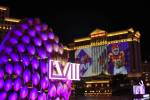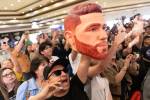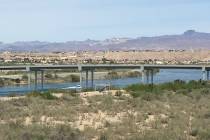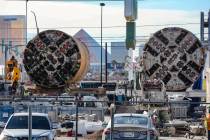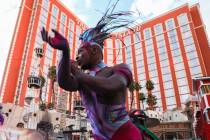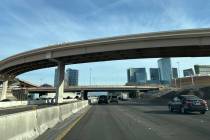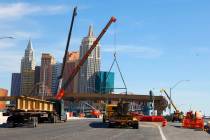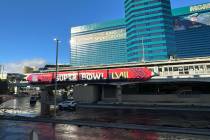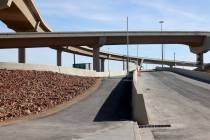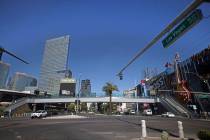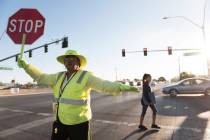If you want federal cash, you gotta love HOV lanes
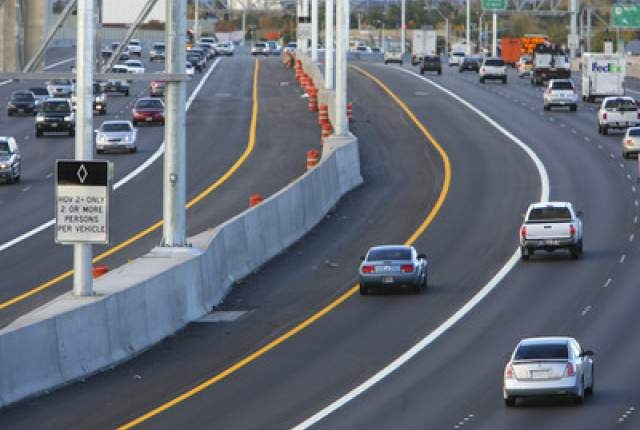
I felt like Luke Skywalker entering the guarded trench of the Death Star, trying to make it to that two-meter-wide exhaust port, itching to launch my proton torpedoes.
Minus the giant cannons sending a barrage of laser shots at my X-wing, of course.
I had just crossed over the solid white line separating the valley’s first high-occupancy vehicle, or HOV, lane from the rest of U.S. Highway 95.
There were no cars in front and none in back of me. I drove at my own pace.
It was as if I had entered a “Star Wars” fantasy world of freeway travel where my passengers and I were protected by an invisible force field from the harsh reality of U.S. 95: weaving sports cars, speeding pickups, and non-turn-signal-using SUVs.
Simply because I was driving some friends from lunch.
A bottleneck occurred at the Rainbow Curve, where U.S. 95 narrows from five lanes to three.
The HOV lane is a major reason for the bottleneck.
Of course, my passengers and I weren’t affected because we were in the HOV lane and drove past the slowing mulch of automobiles.
Then, just like in “Star Wars,” Darth Vader speeded up behind me in the form of a minivan-driving man and his family.
Apparently, I wasn’t driving fast enough.
So far, speeding has been the No. 1 problem with the HOV lanes, according to trooper Kevin Honea of the Nevada Highway Patrol.
The speed limit is the same in the HOV lanes as in the other freeway lanes, Honea said. “It’s not the Autobahn.”
During my HOV experience, the minivan driver was so impatient, he left the HOV lane to pass me and my compadres.
There aren’t any hard numbers yet about how many drivers are using the lanes. Those statistics aren’t expected until after the New Year, said Bob McKenzie, spokesman for the Nevada Department of Transportation.
It seems, though, that with each passing week more commuters are jumping into the HOV lanes, which are reserved for vehicles carrying more than one person and motorcycles and buses regardless of the number of passengers.
But even when we get those numbers, they won’t tell us how many of those motorists are driving sans passengers.
Honea said the Highway Patrol hasn’t tallied how many tickets have been issued for violating the HOV lane rules.
He has pulled two people over for speeding and found them to be the lone person in the vehicle.
“One told me he thought he was being pulled over because there was only one person in the car. I then informed him I pulled him over for doing 78 mph in a 60 mph zone,” Honea said.
Honea gave that motorist, and another he pulled over for speeding, a pass on the HOV violation, even though they knew they were violating the law, he said.
They both received speeding tickets, a quick lesson on the HOV law and a warning that future violations could cost them $250.
At this point, there are only 7.3 miles of HOV lanes on the southbound side of U.S. 95 and 6.6 miles northbound. They are the first in a regionwide plan to put them on the valley’s freeways to benefit express-bus service and encourage carpooling.
But do valley residents really want HOV lanes? Are we all going to start carpooling, considering the myriad of work schedules in this community? Does today’s society even allow for carpooling with adults often holding two jobs to make ends meet?
The answer is, it doesn’t much matter what we might answer, because the federal government is forcing carpool lanes on us.
I recently spoke about this with the folks at the Transportation Department, and they admitted that if the widening plan for U.S. 95 didn’t include alternative means of transportation, federal money for the project would not have been available.
That’s despite recent studies that call into question the effectiveness of HOV lanes.
Researchers at the University of California, Berkeley and California State University, East Bay studied HOV lanes in the environmentally conscious San Francisco Bay area.
The study, which you can download at paleale.eecs.berkeley.edu/~varaiya/papers_ps.dir/HOV.pdf, concluded those HOV lanes increased congestion, did not significantly boost the throughput of people and did not encourage carpooling.
Not exactly the intended results.
According to the study, the number of folks carpooling dropped throughout California from 2000 to 2004, even as the number of carpool lane miles increased. According to media reports, the same results have been seen in other states, including Massachusetts.
But the federal government continues to force the concept on metropolitan areas. And the Transportation Department has to go along with it if they want the money to improve valley roads.
I admit, pretending to be Luke Skywalker while driving in an HOV lane might be letting my imagination get the best of me.
But something tells me that if the Transportation Department and the federal government think valley residents are going to warm up to carpooling, and be more accepting of HOV lanes than San Franciscans, someone is suffering from delusions of grandeur.
If you have a question, tip or tirade, call the Road Warrior at 387-2904, or e-mail him at roadwarrior@reviewjournal.com or fmccabe@reviewjournal.com. Please include your phone number.
ROAD WARRIORMORE COLUMNSDiscuss this column in the eForums! The Nevada Department of Transportation announced the following road disruptions for maintenance work:
The southbound U.S. Highway 95 offramp to Lake Mead Parkway will be closed until 8 a.m. today to replace a damaged impact rail. Motorists should exit the freeway at Horizon Drive.
Maintenance crews will be repairing a guardrail on U.S. 95 southbound between Valley View Boulevard and Interstate 15 from 11 p.m. Dec. 16 to 5 a.m. Dec. 17. Motorists should watch for lane shifts and traffic controls.
Storm drain construction on John Herbert Boulevard, between Centennial Parkway and Buffalo Drive, is expected to wrap up Tuesday, the city of Las Vegas public works department announced. Until then, the road will remain closed.
Motorists can expect street disruptions on Stewart Avenue at 13th Street until Friday for utility work and on Washington Avenue at J Street until Dec. 21 for traffic signal work, according to the city of Las Vegas public works department.




